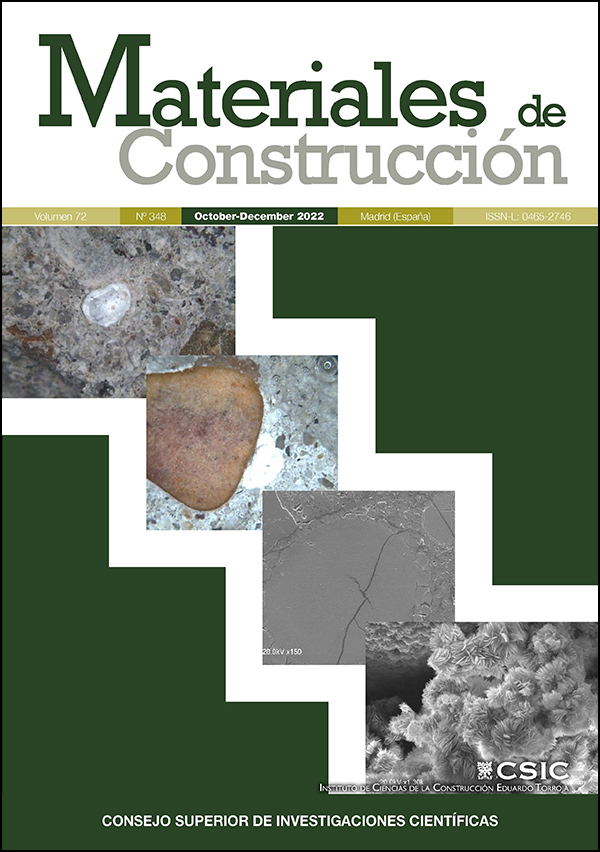The application of coal mining waste to the production of construction ceramics: radiological and mechanical aspects
DOI:
https://doi.org/10.3989/mc.2022.01822Keywords:
NORM, Mining waste, Ceramics, RadioactivityAbstract
The article presents the results of research on the physical and radiological properties of building ceramics made of mining waste. One method of using mining waste is to use it as aggregate in road construction. However, this alone is not enough to dispose of the entire amount of waste generated. Another promising method of using mining waste is the production of building ceramics (bricks). However, some properties (e.g. the content of natural radionuclides) of the waste may limit the possibility of such use. In the scope of this work, the properties of bricks made from mining waste - shale collected from dumps, were examined. It has been shown that the properties of bricks prepared in this way meet the criteria set out in various standards and legal acts and can be used in construction.
Downloads
References
Murmu, A.L.; Patel, A. (2018) Towards sustainable bricks production: An overview. Constr. Build. Mater. 165, 112-125. https://doi.org/10.1016/j.conbuildmat.2018.01.038
Puertas, F.; Suárez-Navarro, J.A.; Alonso, M.M.; Gasco, C. (2021) NORM waste, cements, and concretes. A review. Mater. Construcc. 71 [244], e259. https://doi.org/10.3989/mc.2021.13520
Subashi De Silva, G.H.M.J.; Hansamali, E. (2019) Eco-friendly fired clay bricks incorporated with porcelain ceramic sludge. Constr. Build. Mater. 228, 116754 https://doi.org/10.1016/j.conbuildmat.2019.116754
Kusiorowski, R.; Zaremba, T.; Piotrowski, J. (2014) The potential use of cement-asbestos waste in the ceramic masses destined for sintered wall clay brick manufacture. Ceram. Int. 40, 11995-12002. https://doi.org/10.1016/j.ceramint.2014.04.037
Luo, L.; Li, K.; Fu, W.; Liu, C.; Yang, S. (2020) Preparation, characteristics and mechanisms of the composite sintered bricks produced from shale, sewage sludge, coal gangue powder and iron ore tailings. Constr. Build. Mater. 232, 117250. https://doi.org/10.1016/j.conbuildmat.2019.117250
Lemougna, P.N.; Yliniemi, J.; Ismailov, A.; Levanen, E.; Tanskanen, P.; Kinnunen, P.; Roning, J.; Illikainen, M. (2019) Recycling lithium mine tailings in the production of low temperature (700-900 oC) ceramics: Effect of ladle slag and sodium compounds on the processing and final properties. Constr. Build. Mater. 221, 332-344. https://doi.org/10.1016/j.conbuildmat.2019.06.078
Stolboushkin, A.Y.; Ivanov, A.I.; Fomina, O.A.(2016) Use of coal-mining and processing wastes in production of bricks and fuel for their burning. Procedia Eng. 150, 1496 - 1502. https://doi.org/10.1016/j.proeng.2016.07.089
Kusin, F.M.; Munirah, S.N.; Hasan, S.; Hassim, M.A.; Molahid, V.L.M. (2020) Mineral carbonation of sedimentary mine waste for carbon sequestration and potential reutilization as cementitious material. Environ. Sci. Pollut. Res. 27, 12767-12780. https://doi.org/10.1007/s11356-020-07877-3
PMid:32008190
Lemougna, P.N.; Yliniemi, J.; Adediran, A.; Luukkonen, T.; Transkanen, P.; Finnilä, M.; Illikainen M. (2021) Synthesis and characterization of porous ceramics from spodumene tailings and waste glass wool. Ceram. Int. 47 [23], 33286-33297. https://doi.org/10.1016/j.ceramint.2021.08.231
Adediran, A.; Lemougna, P.N.; Yliniemi, J.; Transkanen, P.; Kinnunen, P.; Roning, J.; Illikainen, M. (2021) Recycling glass wool as a fluxing agent in the production of clay- and waste-based ceramics. J. Clean. Prod. 289, 125673. https://doi.org/10.1016/j.jclepro.2020.125673
Rubin, J.A. (2019) The influence of material and technological factors on radon exhalation from concrete with a cement matrix. Monograph. Publishing house of the Silesian University of Technology. Gliwice, 2019.
Gawor, L. (2014) Coal mining waste dumps as secondary deposits - examples from the Upper Silesian Coal Basin and the Lublin Coal Basin. Geol. Geophys. Environ. 40 [3], 285-289. https://doi.org/10.7494/geol.2014.40.3.285
Abramowicz, A.; Rahmonov, O.; Chybiorz, R. (2021) Environmental management and landscape transformation on self-heating coal-waste dumps in the Upper Silesian Coal Basin. Land. 10, 23. https://doi.org/10.3390/land10010023
Szczepanska-Plewa, J.; Stefaniak, S.; Twardowska, I. (2010) Coal mining waste management and its impact on the groundwater chemical status exemplified in the Upper Silesia Coal Basin (Poland). Pol. Geol. Inst. Spec. Pap. 441, 157-166.
Fecko, P.; Tora, B.; Tod, M. (2013) Coal waste: handling, pollution impacts and utilization. The coal handbook: towards cleaner production: Volume 2: Coal Utilisation. https://doi.org/10.1533/9781782421177.1.63
Murzyn, P.; Pyzalski, M. (2018) Characteristis and assessment of the suitability of coal-rich mining waste in the production of ceramic building materials. Multidisc. J. Waste Resour. Resid. 1, 30-37.
Council Directive 2013/59/Euratom of 5 December 2013 laying down basic safety standards for protection against the dangers arising from exposure to ionising radiation, and repealing Directives 89/618/Euratom, 90/641/Euratom, 96/29/Euratom, 97/43/Euratom and 2003/122/Euratom.
Klinkenberg, L.J. (1941) The permeability of porous media to liquids and gases. American Petroleum Institute, Drilling and Production Practices, Dallas, 200-213.
Leonardi, F.; Bonczyk, M.; Nuccetelli, C.; Wysocka, M.; Michalik, B.; Ampollini, M.; Tonnarini, S.; Rubin, J.; Niedbalska, K.; Trevisi, R. (2018) A study on natural radioactivity and radon exhalation rate in building materials containing NORM residues: preliminary results. Constr. Build. Mater. 173, 172-179. https://doi.org/10.1016/j.conbuildmat.2018.03.254
Sahoo, B.K.; Mayya, Y.S. (2010) Two dimensional diffusion theory of trace gas emission in soil chamber for flux measurements. Agric. For. Meteorol. 150, 1211-1224. https://doi.org/10.1016/j.agrformet.2010.05.009
Published
How to Cite
Issue
Section
License
Copyright (c) 2022 Consejo Superior de Investigaciones Científicas (CSIC)

This work is licensed under a Creative Commons Attribution 4.0 International License.
© CSIC. Manuscripts published in both the print and online versions of this journal are the property of the Consejo Superior de Investigaciones Científicas, and quoting this source is a requirement for any partial or full reproduction.
All contents of this electronic edition, except where otherwise noted, are distributed under a Creative Commons Attribution 4.0 International (CC BY 4.0) licence. You may read the basic information and the legal text of the licence. The indication of the CC BY 4.0 licence must be expressly stated in this way when necessary.
Self-archiving in repositories, personal webpages or similar, of any version other than the final version of the work produced by the publisher, is not allowed.
Funding data
Ministerstwo Edukacji i Nauki
Grant numbers 11158010
















